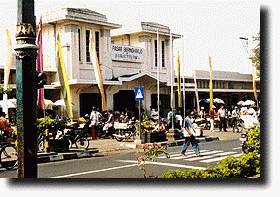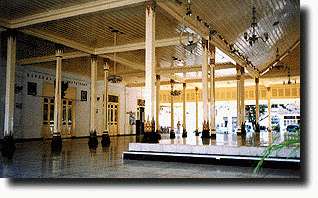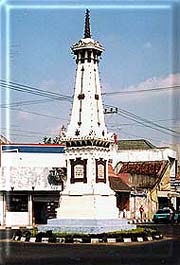In the middle of south Central Java lies the magical region of Yogyakarta, the cradle of Javanese culture and tradition. In the north the volatile, Mount Merapi – the Fire Mountain with captivating physical beauty stands vigorously guarding the surrounding nature. This gigantic volcano, sometimes dangerous with its eruption and lava spitted from its crater, but at the same time gives tremendous fertility to the land. That's the reason why the farmers – inhabitants living in its slope do not want to leave their ancestor's place of birth. They have a mystical relation with Merapi to live in harmony with 'the rulers' of the mountain to keep them safe and peaceful.
The palace of Yogyakarta gives regular offering in Ngestiaji, north of Kinahrejo Village, on the southern slope of Merapi. Mbah Marijan, a native of Kinahrejo is assigned by Karaton Yogyakarta as the gatekeeper (Juru kunci) of this mountain.
The region's south border is Indian Ocean or locally known as Segoro Kidul in Javanese meaning South Sea with its continuos crashing waves. Many believe this area is mystically ruled by Kanjeng Ratu Kidul, the goddess of the South Sea who had made an agreement with Panembahan Senopati, the first king of Mataram Kingdom II to always protect Mataram and its people from calamity. The palace regular offerings in certain dates is done on the white sandy beach of Parang Tritis always attract many spectators, local and foreign.
The Gunung Sewu, limestone thousand hills occupies the Southeast border of Yogya. This area is not fertile but full with mystical tales asceticism of the past. The rest, except the mountain range of Menoreh in the Northwest is fertile lowland.
The citizens of Yogya feel the chains of magical power with pride in this modern time too. Although they belong to a highly cultural society, most of them remain low profile while selectively embracing the benefit of modernisation.
MEMORY of THE OLD TIME
In the middle of the city stands the magnificent palace or Karaton Ngayogyakarta Hadiningrat. This Karaton was built in 1756, the architect was Sultan Hamengkubuwono I, the first king of Yogyakarta.
The present Sultan Hamengkubuwono X is currently also the governor of Yogyakarta Special Region
Some experts say that Ngayogyakarta is taken from the words ng-ayu-agyo-karto (ayu : beautiful, noble, agyo from ageyo : built, karto : prosperous), it has a meaning that the country was built with a noble wish to bring prosperity.
The other palace in Yogyakarta is Puro Pakualaman (built in 1813), located in Jl. Sultan Agung, 2 km east of the city's centre. The architect of this Puro was Sri Pakualaman I.
Taman Sari
The water castle evocative ruins, built in 1758, located west of Karaton. It was once a splendid pleasure park of the Sultans and Royal Families, and badly damaged due to an eathquake in 1865. The bathing pools have been restored, the rest is an interesting place of eerie ruins, underground passages and a large subterranean mosque.
Nowadays, it becomes a kampung (village) where small houses and art galleries stand.
Kote Gede - The First Capital of Mataram Kingdom II
 |
it is located 5 km south east of the city's centre. Panembahan Senopati, the first king of Mataram, built this small town in 1582. His sacred grave is there behind the old mosque of the town.
Nowadays Kota Gede is famous with its silver industry.
Mataram Gate |
Museum Sonobudoyo
The Javanese style museum in the North Square. It was built by Java Institute and has rich collections of Javanese artistic heritage, including; old books, literatures and arts, wayang, masks, keris, batik and some statues.
At present, every evening wayang kulit or leather puppet shorted performances are held here from 08.00 - 10.00 pm.
Gedung Agung
This huge magnificent mansion was formerly the resident of the Dutch Governor, when Yogyakarta was temporary capital of the Republic of Indonesia in 1946 - 1949, this building was the domicile of the President.

Gedung Agung
Seni Sono
Just next to Gedung Agung is the Seni Sono Art Center.
Fort of Vredeburg
In front of Gedung Agung is Benteng Vredeburg, an Old Dutch Fort. The restored fort now is a museum showing the history of independent movement.

Fort Vredeburg
Taman Budaya Yogyakarta
The cultural center, located east of Fort Vredeburg, a place of cultural activities. The experts live in this city are among other :
- Prof. Dr. Wisnu Wardana
- Prof. Dr. Sudarsono
- Prof. Dr. Umar Khayam
- Mr. Karkono
- Mr. Bakdi Sumanto
- Mr. Bagong Kussudiardjo
- Mr. Didik Nini Towok
- Mr. Emha Ainun Najib
- Mr. Linus Suryadi
- Prince Yudaningrat
- R.M. Dinussatomo
- R.M. Wibatsu
- R.M. Tamdaru
- Mr. Saptoto
- Mr. Suryanto Sastroatmodjo
- K.R.T. Wasitodiningrat
- Mr. Amri Yahya
- Mr. Saptoto
- Prince Puger
- Mr. Suryanto Sastroatmojo
The Bank and Main Post Office Edifices
 |
These beautiful colonial buildings are located north of Karaton's North Square. Several hundred eastwards are an old Catholic Church at Jl. Secodiningratan.
Post Office
|
Pasar Beringharjo
The old traditional market lies in the very centre of the city in the famous main thoroughfare, Jl. Malioboro. All manner of produce are sold here.

Beringharjo Market
Kepatihan Danurejan
It was the Dalem (mansion) and office of the Patih (Sultan's Chief Minister) during feudal (colonial time). The official name of every Patih of Karaton Yogyakarta was Danurejo, So the building is locally known as Kepatihan Danurejan, now is the office of the Governor of Yogyakarta Special Region, located North of Beringharjo Market.

The Hall of Kepatihan "Danurejan"
Stasiun Tugu
The main railway station with its colonial style located north of Kepatihan , south of Tugu. It is a very convenient station with regular connections to Jakarta, Solo, Semarang, Surabaya and other cities in Java.
Tugu
A monument stands in the crossroad of Jl. Malioboro and Jl. Sudirman. It has a symbolic meaning for the meditation and it is one of the magical line of Yogya, consisting of (south to north); the South Sea, the Karaton Yogyakarta, Tugu and Mount Merapi.

Tugu
(Suryo S. Negoro)
to The New City ...
